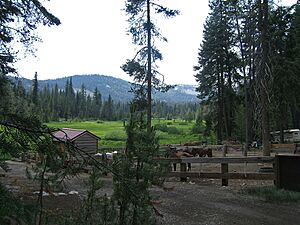Drakesbad Guest Ranch facts for kids
Drakesbad Guest Ranch, often called Drakesbad, is a unique resort found near Chester, California. It's located right by Hot Springs Creek in Warner Valley, deep inside Lassen Volcanic National Park. This special place is known for its natural hot springs and a relaxed, old-fashioned charm.
Contents
The Story of Drakesbad
How Drakesbad Began
The history of Drakesbad started in the 1880s with a man named Edward R. Drake. He was a trapper and miner who decided to settle down. Around the late 1870s, Drake built a cabin in the Hot Springs Valley. He slowly gathered about 400 acres of land, which included several natural hot springs and other volcanic features. Drake used the land to keep his cattle during the summer months. In 1900, he sold his "Drake's Hot Springs and Ranch" to Alexander Sifford.
The Sifford Family Takes Over
Building a Guest Ranch
Alexander Sifford was a schoolteacher from Susanville. He came to the valley in 1900 hoping the mineral waters would help him feel better. After just three days, Sifford decided to buy the property from Drake for $5,000. Alexander and his wife, Ida Sifford, then started a guest ranch. They made Drake's old bathhouse and guest cabin bigger. In 1901, they bought more land, including part of Boiling Springs Lake.
At first, they called their place the "Mount Lassen Hot Springs Hotel." But by 1908, they settled on the name "Drakesbad." Around 1912, with new money, the Siffords built a dining room, a kitchen, and twenty tent platforms. This allowed them to charge more for stays. They also dug ditches to drain the wet areas around the property. This created meadows where they could grow hay for their animals.
Surviving Challenges
The big eruptions of Lassen Peak in 1914–1915 brought many tourists to the area. This greatly increased business at Drakesbad. When Lassen Volcanic National Park was created, Drakesbad became a handy spot for park workers to stay. The park's first superintendent even thought about building the park's main office near Drakesbad.
For a while, the Warner Valley Road was the main way visitors got to the park. But new roads were finished in 1931, making other parts of the park easier to reach. By 1936, the Siffords had added a fishing pond called Dream Lake and four wooden cabins.
A tough winter in 1937–1938 caused a lot of damage. Heavy snow destroyed the original Drake lodge. The fishing pond was washed out, and many other buildings were damaged. The roads were almost impossible to use. The Siffords, with their son Roy helping manage, quickly hired a local builder. He built a brand-new lodge in just ten days, finishing on June 30, 1938. Guests were even sleeping in their beds that very night! The Dream Lake dam was fixed the next year.
During World War II, the Siffords raised cattle on their land. They continued raising cattle until 1951. More cabins were built in the late 1940s. By 1952, the property had 28 buildings. These included the lodge, dining hall, kitchen, bathhouse, swimming pool, and many cabins and sheds.
However, Ida Sifford passed away in 1951. Her daughter Pearl also became very sick. Another hard winter in 1951–1952 damaged many structures again. The National Park Service then offered to buy the property. After some talks, the Siffords sold Drakesbad to the Park Service for $325,000 in 1953.
Drakesbad Becomes a National Park Gem
Before the sale, Roy Sifford had let Don Hummel manage the ranch. Hummel continued to run Drakesbad as a park concession after the Siffords fully left in 1958. Hummel added two more cabins. In the 1960s, the Park Service added three more cabins and replaced the swimming pool and bathhouse. A new sewage system was also put in around 1960.
The original Sifford cabin and a few other very old buildings were taken down in the 1960s.
Drakesbad Guest Ranch is located at about 5,700 feet above sea level. It's famous for using kerosene lamps, even though the main lodge got electricity in the 1990s. Another unique thing is that there are no room keys!
Why Drakesbad is Special
The Drakesbad Guest Ranch was officially listed on the National Register of Historic Places on October 22, 2003. This means it's recognized as an important historic site. In November 2007, the Los Angeles Times newspaper even included Drakesbad in a list of the top 15 places to visit in California.



